| A | B |
|---|
| A ball of gas that is hot enough to sustain nuclear fusion reactions giving off tremendous amounts of electromagnetic energy is known as a(n) ____. | star |
| A ball of gas when it can glow, but isn't a full fledged star yet is called a(n) _____. | protostar |
| If a dense ball of gas NEVER gets hot enough start fusing hydrogen-1 as fuel, but can do limited fusion of hydrogen-2, it can be called a(n) ____. | brown dwarf |
| A protostar becomes a star when it becomes hot enough for nuclear _____ of hydrogen-1 to occur at a temperature of 10 million degrees Kelvin. | fusion |
| The combining of smaller atomic nuclei into bigger atomic nuclei causing the release of huge amounts of energy is the definition of a process called nuclear_____. | fusion |
| All stars fuse hydrogen nuclei to create ____ nuclei as their fuel source during the main sequence part of their lifecycle. | helium |
| Clouds of gas and dust in space are called _____. | nebulae (a single one is called a nebula) |
| Clouds of gas and dust clump together due to _____ to form protostars. | gravity |
| When pressure increases inside a protostar, this causes _____ to also increase. | temperature |
| As balls of gas start clumping together due to gravity, ______ increases which causes temperatures to increase. | pressure |
Which letter on the diagram represents where a star would be if it was in the stable main stage of it's lifecycle where it spends most of it's time?,  | C, 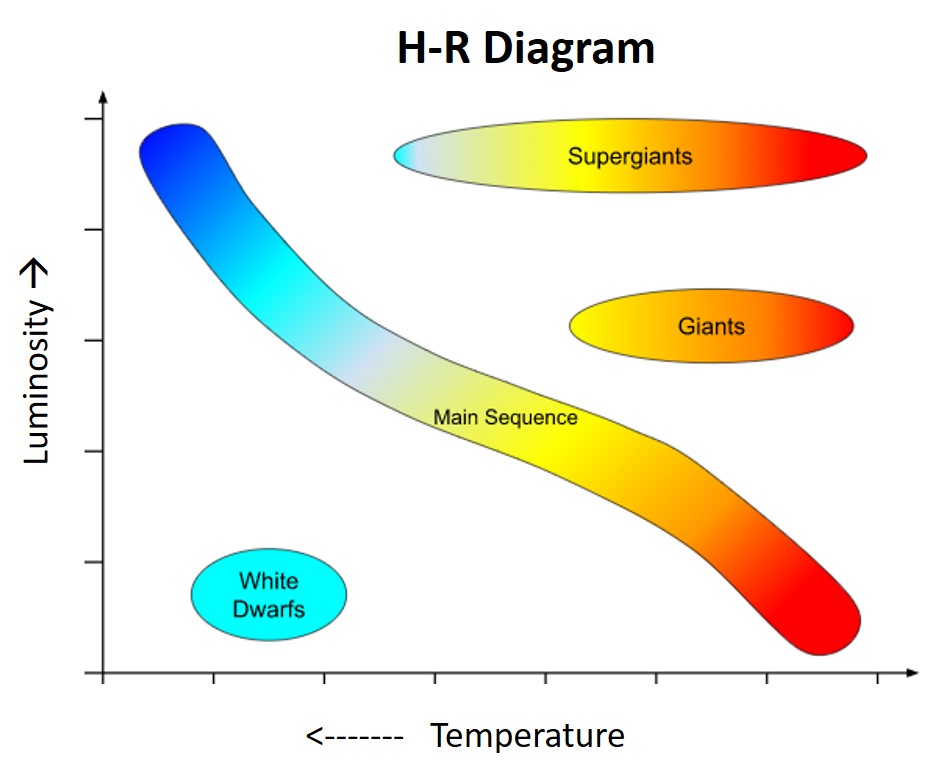 |
Which number on the diagram would our Sun be closest to?,  | 4 (That's right. Our Sun is currently a main sequence yellow star),  |
Which letter on the diagram would our Sun be closest to when it first leaves the main sequence during the final parts of it's life?,  | B (That's right. After our Sun has stopped fusing hydrogen, it will leave the main sequence, start fusing helium, and greatly increase in science to become a Giant for a short period of time.,  |
What is the next labeled step in the stellar evolution of Giants?,  | White Dwarfs (They lose much of their mass by blowing it out toward space, then contract and shrink into hot white dwarfs),  |
Near which letter in the diagram below would you find Supergiants?,  | A,  |
Near which number in the diagram below would you find Red Dwarfs?,  | 5,  |
Near which letter or number would you find stars who will become, or just were, black dwarfs?,  | D (Yes, White Dwarfs will slowly cool down and fade into black dwarfs),  |
Near which number would you find the oldest stars in the universe?,  | 5 (That's right, red dwarfs burn so slowly that they can last a trillion years. The larger and hotter a star, the faster it uses up it's fuel),  |
Near which number or numbers would you find stars that never become Giants or Red Giants, but instead go straight to the White Dwarf Stage after they leave the main sequence?,  | 5 (That's right. Only the lowest mass stars, the Red Dwarfs, turn straight into White Dwarfs without ever going through a Giant or Supergiant phase first),  |
Next to which letter would you find stars that end their lives in one huge explosion?,  | A (Yes, it's the SuperGiants and Hypergiants (not labeled on this diagram) that end their lives in one big Supernova explosion),  |
Next to which number would you find a star that is most likely to have its core end up as a black hole?,  | 1 (Yes, these massive blue giant stars on the main sequence will end up as the biggest stars of all, hypergiants, which will go Supernova leaving behind and impossibly dense core with gravity so great that not even light can escape from it). |
| What can escape from a black hole? | Chuck Norris, but other than that, nothing, not even light.,  |
The color of the surface of a star most directly relates to the ______ at the surface of the star?,  | temperature (notice how the coldest surface temperatures always shine red while the hottest stars always shine blue. The color doesn't always indicate the luminosity. You have both Red SuperGiants and blue stars high on the main sequence with equal luminosities),  |
Next to which letter or number would you find the most massive stars?,  | 1 (Don't confuse mass with size. The hottest stars on the main sequence are the most massive, which also means they have the most gravity and therefore pressure, so they burn through their fuel the fastest achieving super high temperatures and luminosities. When they leave the main sequence, they expand into much bigger Red Giants and Hypergiants, but these stars are blowing gases from their outer layers off into space, so they are losing mass at the same time they are growing in size, so they aren't as massive), 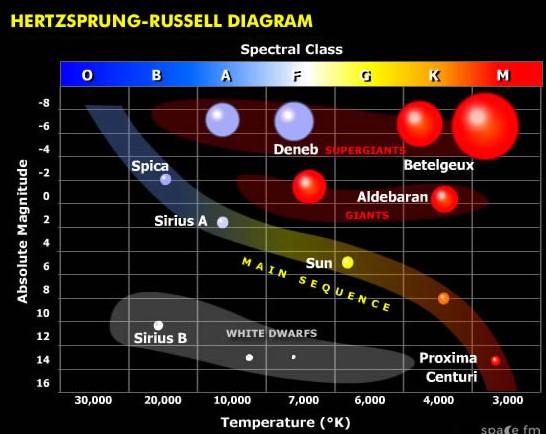 |
Next to which letter or number would you find the biggest stars?,  | A (Yes, the Supergiants (and Hypergiants not pictured) and the biggest stars in the Universe. The biggest star we know of it about 2000 times the diameter of the Sun and would swallow Saturn if it were our star),  |
Next to which number would you find the stars that spend the shortest amount of time on the main sequence?,  | 1 (Yes, these stars are the hottest. Even though they are also the most massive stars on the main sequence with the most fuel, they burn through it very quickly due to the high temperatures and pressures within the core of the star) |
TRUE or FALSE: Stars stay in one place on H-R diagrams throughout the time they spend on the main sequence.,  | FALSE (Stars get hotter and more luminous as they use up their hydrogen and their cores get denser, so they move up and to the left as they age on the main sequence.),  |
| Low mass main sequence stars have masses ________ that of the sun. | a third or less |
| The higher the mass of a star on the main sequence, the ______ its lifespan | shorter |
| _____ mass stars will only fuse hydrogen during their lifetime, unlike all other stars that will switch over to helium and some to even heavier elements during their lifetime. | Low |
| Right after low mass stars leave the main sequence, they become ______. | white dwarfs |
| Medium mass stars have a mass ______ that of the Sun | 1/3rd to 8 times |
| Our Sun is a _______ mass star. | medium |
________ Nebulae (pictured here) are clouds of gas that came from a Red Giant and are now being illuminated by the white dwarf that remains of the star., 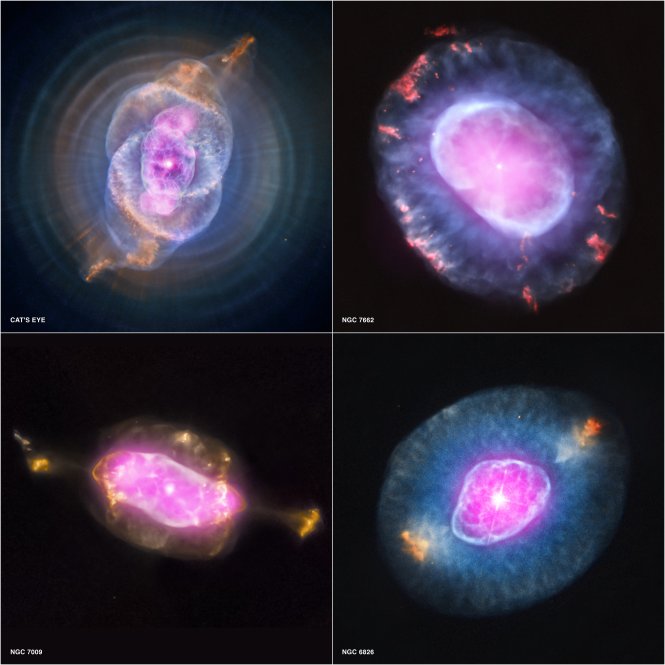 | Planetary,  |
What is illuminating these balls of gas called Planetary Nebulae?,  | A white dwarf at the center (The white dwarf is all that remains of the Red Giant that blew off its outer layers of gas long ago),  |
| The biggest stars in the Universe are called __________ | Hypergiants, 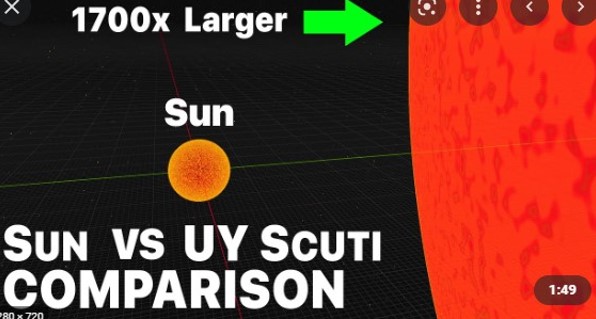 |
| The heaviest element that can be made inside a star (before it explodes) is _____. | iron |
| When Supergiants and Hypergiants explode, the explosion is called a(n) ______. | Supernova |
| When a Supernova occurs, the left-over core usually collapses into a small dense mass called a neutron star and if the star is really really big, the core could totally collapse and become ______ | black hole |
| When a Supernova occurs, the left-over core usually collapses into a small dense mass called a(n) ______ star and if the star really really big, the core could totally collapse and become black hole | neutron star |
| The gravitational force near the surface of a black hole is so great that nothing, not even ____ , can escape. | light |
| A star that is made up of two stars orbiting each other is called a(n) ______ star | binary, 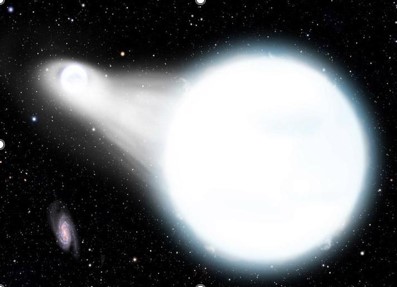 |
| A white dwarf orbiting a Red Giant can end up exploding over and over again in an event called a(n) ______ due to pulling gasses away from the Red Giant and becoming temporarily unstable. | Nova, 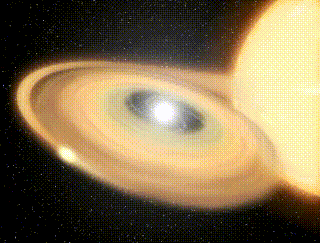 |
| The further apart two stars are in a binary star system, the ______ they orbit each other. | slower (Notice how these binary stars change their speed as they get closer and further from each other),  |
| A(n) _____ is a large-scale group of stars, gas, and dust that is bound together by gravity. | galaxy |
| Most galaxies are thought to have a supermassive _____ at the center. | black hole |
Which type of galaxy is pictured here?, 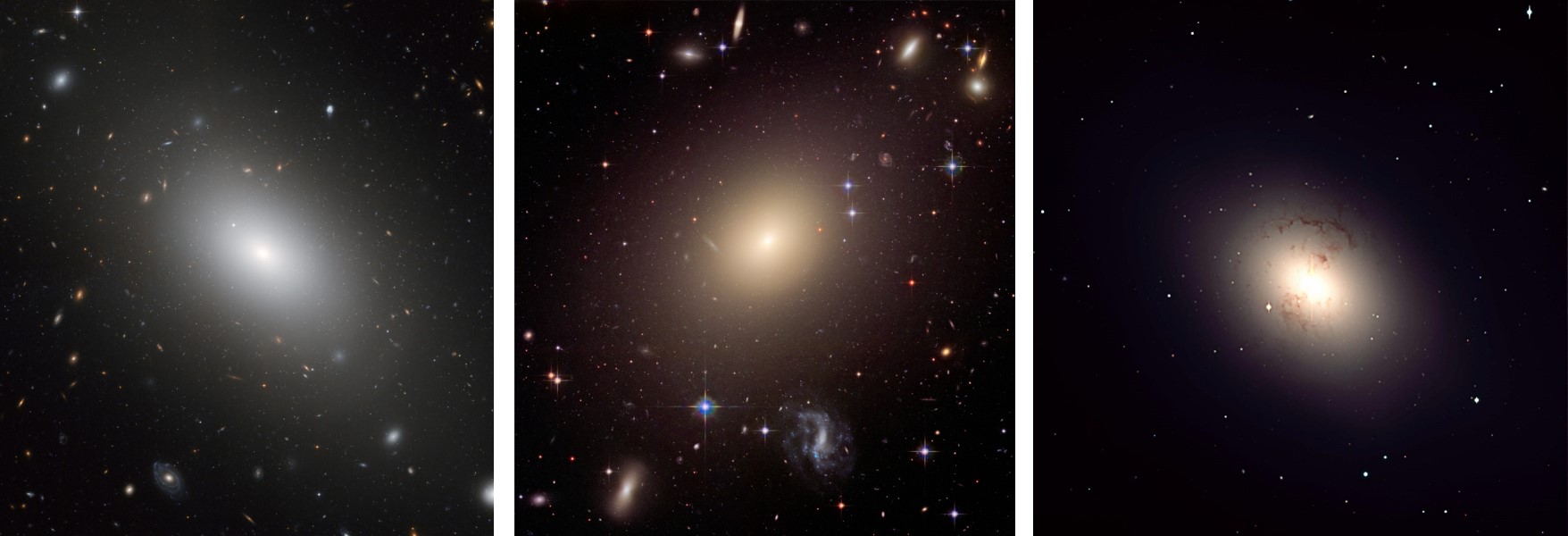 | Elliptical,  |
| Which type of galaxy has mostly small old stars and little gas or dust? | Elliptical |
Which type of galaxy is pictured here?,  | Irregular,  |
| Which type of galaxies have no defined shape and may include galaxies that are merging? | Irregular,  |
| Which type of galaxies have a flattened disc shape and arms? | Spiral, 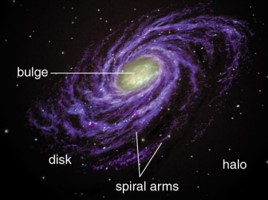 |
Which type of galaxy is pictured below?,  | Spiral,  |
| Which type of galaxy is our Milky Way classified as? | Spiral,  |
In which region of this galaxy would you find large bright young stars? (You can name it or give the letter),  | arms or (C),  |
The area labeled C is called ____.,  | arms,  |
The area labeled B is called the ____.,  | bulge |
The area labeled A is called the ____.,  | halo (the halo is an elliptical shaped region surrounding the arms of the spiral galaxy. It's basically the outer region)),  |
The type of galaxies that send an extremely strong beam of light and matter from the black hole area out in both directions perpendicular to the flattened disc portion of the galaxy are called _____ galaxies., .jpg) | Active, .jpg) |
| The leading theory on how the universe started and continues to evolve to this day is called the ________ theory. | Big Bang |
| Evidence suggests that the Universe ______ years old. | 13.8 billion |
| A well-tested explanation that unifies a broad range of observations is called a(n) ______. | scientific theory |
| TRUE or FALSE: A scientific theory is basically just a hypothesis because it hasn't been tested yet. | FALSE (In order to gain the status of a scientific theory, it had to have been extensively tested and is backed up with enough data that the overwhelming majority of scientific experts on the topic conclude that the theory is the best current explanation for something based on all available evidence. A scientific theory is not just an untested hypothesis)) |
| The study of the origin, structure, and future of the universe is called _______. | cosmology (Do not get this confused with "cosmetology" which is the professional skill or practice of beautifying the face, hair, and skin.) |
| Just before the universe started to expand, all the energy in the Universe today was in one tiny spot. That spot was called a(n) _______. | singularity |
| TRUE or FALSE: In the tiniest fractions of a second during which the universe first started to expand, there was energy but no matter. | TRUE (It wasn't until a tiny fraction of a second later that a lot of this pure energy was transformed into matter, as predicted by Einstein's equation E=mc^2) |
| TRUE or FALSE: Matter can be transformed into energy, but energy can't be transformed into matter. | FALSE (Matter can be transformed into energy and energy can be transformed in matter) |
| Out of the 4 basic forces, the force of _______ is the force responsible for attracting large objects together. | gravity |
| Out of the 4 basic forces, the ___________ force is the force that attracts oppositely charged particles and repels particles of the same charge. | electromagnetic |
| Out of the 4 basic forces, the _______ force is the force that allows protons and neutrons to stick together and form a nucleus even though protons repel each other because they have the same charge. | strong nuclear |
| Out of the 4 basic forces, the _______ force is the force that is responsible for radioactive decay of the nucleus in radioactive elements. | weak nuclear |
| By _________ after the Big Bang, the universe had cooled just enough for the fundamental particles to start coming together to form protons and neutrons. | 1 second |
| By _________ after the Big Bang, the universe had cooled enough for protons and neutrons to start sticking together to form the first atomic nuclei. | 3 minutes |
| When protons and neutrons first started sticking together to form atomic nuclei, the nuclei that were formed were about 75% hydrogen and 25% helium with a small amount of _____ also.. | lithium |
| By _________ after the Big Bang, the universe had cooled to the point where nuclear fusion could no longer take place and the nuclei of hydrogen and helium stopped forming (at least until 200 million years later when stars started forming) | 20 minutes |
| By _________ after the Big Bang, the universe had cooled enough for electrons to be able to settle around the nuclei of hydrogen and helium to form the first complete atoms. | 380,000 years |
| By 380,000 years after the Big Bang, the universe had cooled enough for _______ to be able to settle around the nuclei of hydrogen and helium to form the first complete atoms. | electrons |
| When the universe had expanded and cooled to the point where electrons could finally settle into orbitals around the nuclei of hydrogen and helium, a tremendous burst of light was given off. This burst of light is still detectable as the _____. | Cosmic Background Radiation (Can also be called the Cosmic Microwave Background), 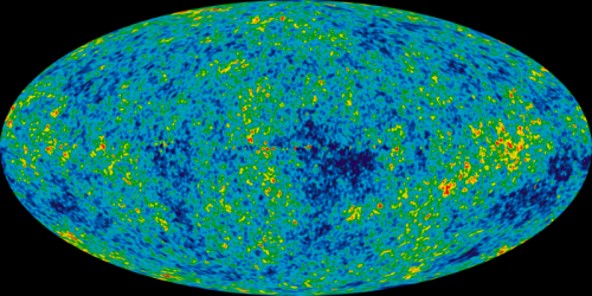 |
| By _________ years after the Big Bang, the earliest stars in the Universe were starting to form. | 200 million |
| For helium nuclei (atomic # = 2) to form during the first 20 minutes of the universe, ______ nuclei would have to fuse with each other | hydrogen |
| Hubble's Law states that other galaxies in the universe are moving away from us and the farther away the object is, the _____ it is moving away from us. | faster |
| The minimum temperature required for sustained nuclear fusion of hydrogen-1 is ______ degrees Kelvin. | 10 million |